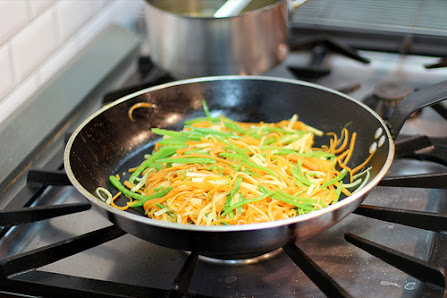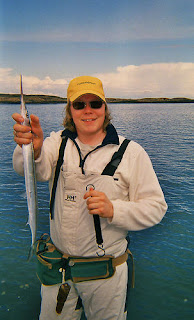from
Behind the French Menu
by
Bryan G. Newman
behindthefrenchmenu@gmail.com
The red bream
www.flickr.com/photos/noaaphotolib/9734691415/
Béryx or Alfonsino on French menus is nearly always the fish called in the UK Red Bream though sometimes the names Alfonsino and Cuvier's Berycid Fish are used. In a fishmonger’s or in a supermarket this fish’s bright orange-red color, with a white to yellow breast and huge eyes make identification easy. These fish live in waters below 500m (540 yards) where large eyes are needed as there is very little light. The fish’s average length is 30 cm (12”) though they have been caught as large as 100cm (36”). Since the average weight of a landed fish is 2 kg (4.4 lbs.), the fish will be served in filets.
Grilled red bream with hen of the woods mushrooms.
www.flickr.com/photos/ykjc9/2890512232/
The taste of red bream
The red bream has sweet, white to pink, very tasty, but slightly flaky meat. The red bream reaching French tables come from the North Atlantic between Ireland and Norway, it will not be caught in the Mediterranean. Other members of the bream family and other redfish are on menus in North America including sea farmed fish, but the European red bream is rarely on North American menus.
Beryx – Red Bream on French Menus:
Beryx de Saint-Jean-de-Luz, Fenouil, Cerfeuil, Cresson, Ail Frit, Vinaigrette Citron, Oignons – Red bream from the fishing port of Saint-Jean-de-Luz on France’s Atlantic coast in the region of Nouvelle Aquitaine close to the Spanish border. The fish is prepared with fennel, chervil, watercress, fried garlic, and served with a lemon vinaigrette and onions. Saint-Jean-de-Luz was initially an important whaling port and has since changed itself into a serious tuna fishing port. They have a daily open auction for the sale of the fish they catch, not just tuna; it is well worth watching. One mile from the town are beautiful sandy beaches and 18km (11 miles) away is the resort town of Biarritz and just 26 km (16 miles) away is the capital of the Basque Country the city of Bayonne.
In Saint-Jean-de-Luz, there are celebrations nearly every month, and sometimes twice a month, most have food, fish, and seafood at their center though others are built around music and art.
Fetes du Thon, the tuna fete is held on the second Saturday in July. Then apart from stalls selling all kinds of tuna products, there are stalls selling wines, cheese, and ham; to that add restaurants offering tuna-centric menus and all over town there are bands playing Basque music.
.
The town of Saint-Jean-de-Luz has an English language website with all the dates and information:
Saint-Jean-de-Luz
www.flickr.com/photos/jssz/8004178427/
Tartare de Béryx, Salicorne et Daikon – A tartar of red bream, salicorne and daikon radish. Salicornia or Samphire is often, mistakenly, called an edible seaweed; it is not. Salicornia grows on land close to the shore. Its shape, not its taste, also gave Salicornia another name, Sea Asparagus.
The Daikon, Japanese or Chinese radish, also called the white radish and the giant radish is a mild radish unless it is pickled to make it spicy; it is served both fresh and cooked. French chefs use the daikon like other radishes as well as creating recipes that emphasize the daikon’s different texture.
Papillote de Beryx sur une Julienne de Légumes - Dishes that are prepared en papillote are wrapped in parchment paper (grease-proof paper) bag or aluminum foil and then cooked in an oven. Inside the wrapping will be all the herbs, spices and vegetables that will flavor the dish. The bag puffs up while cooking but remains sealed, and all the moisture and flavors remain. The bag will be opened in front of the diner so that he or she may appreciate the smells as the bag is removed. On this menu listing the red bream with the vegetables and herbs that were cooked together are served on top of a julienne of vegetables. The word Julienne indicates that someone, in the kitchen, has spent a great deal of time cutting vegetables into very exact shapes and sizes. Officially Julienne vegetables should be 0.2 cm x 0.2 cm x 5 cm long.
Sauteing a julienne of mixed vegetables.
Filet de Beryx, Carottes Glacées, Coquillages, Beurre Persillé – A filet of red bream served with glazed carrots, shellfish, and parsley butter. Nearly all red bream will be served as fillets as most fish are large. The fish is accompanied by glazed carrots and mussels, or possibly clams. The parsley butter that accompanies the dish will be a compound butter, made from a mixture of parsley and butter that is then kept solid in the refrigerator until needed. The pats of parsely butter will be placed on the fish as it is served so that it adds flavor while it slowly melts,
Dos de Beryx, Jus Safrané et Risotto Crémeux - A thick cut from the back of a red bream served with its cooking juices flavored and colored with saffron and served with a creamy risotto.
Red sea bream sashimi
Photograph courtesy of City Foodsters
www.flickr.com/photos/cityfoodsters/19297824696/
Red bream have some very close cousins with the closest called the splendid alfonsino, the dorade rose in French. The two fish have the same coloring and in Holland and Italy, there is confusion as the same name is used for these similar but different fish, a fishmonger will, or should, know their Latin names. More confusion comes when the daurade rose is mistakenly put on a menu as the dorade rose. The Daurade Rose with the letter U in the name is the Blue Spotted Sea Bream. Worry not, the occasional misuse of the name will not change the taste.
Chefs often rely on the fishmongers to supply the correct names in other languages. I have been in restaurants where the French name and the English name have no connection. Then, when I have been allowed in the kitchen to see the fish before it is cooked it is usually a bad English translation or spelling. Nevertheless, I have, on a few rare occasions, seen fish whose French and English names have no connection to the fish on the menu listing. In one case the chef picked up his phone to call the fishmonger while in the other he held the knife he used for filleting fish and made violent promises to his ignorant supplier. Luckily, I was not around the next day when the two met.,
Chefs often rely on the fishmongers to supply the correct names in other languages. I have been in restaurants where the French name and the English name have no connection. Then, when I have been allowed in the kitchen to see the fish before it is cooked it is usually a bad English translation or spelling. Nevertheless, I have, on a few rare occasions, seen fish whose French and English names have no connection to the fish on the menu listing. In one case the chef picked up his phone to call the fishmonger while in the other he held the knife he used for filleting fish and made violent promises to his ignorant supplier. Luckily, I was not around the next day when the two met.,
Beryx, Red Bream in the languages of France’s neighbors:(Dutch – roodbaars ), (Germany - südlicher kaiserbarsch ). (Italy - berice rosso ), (Spain - Afonsiño ), (Latin - beryx splendens).
The dorade rose, the beryx’s close cousin
The dorade rose.
The closest cousin of the Red Bream is the Splendid Alfonsino called, the dorade rouge in French. It looks fairly similar and tastes the same, it even has the same texture.
The dorade rose on French menus:
Filet de Dorade Rose à la Plancha, Émincées de Crevettes Sautés, Cresson de Fontaine – The splendid alfonsino prepared on the plancha, that Spanish/Basque creation that allows for a cooking technique between frying and grilling. Here the fish is served with thinly sliced, lightly fried shrimps accompanied by watercress.
Dorade rose barbecued.
www.flickr.com/photos/peterfuchs/4675686128/
Dorade Rose Sauce Créole – The splendid alfonsino served with a French creole sauce from the French Caribbean Islands of Martinique and Guadeloupe. While there are many variations, the most commonly served Sauce Creole is fried shallots, garlic, tomatoes, parsley, paprika and curry powder applied on the French mainland with a light touch. In the islands, more paprika, peppers and curry powder may be added. French mainland dishes are rarely really spicy. There are tens of different French Creole cuisines, France left its imprint all over. The cuisines were created using local ingredients adapted to the tastes of the slaves or indentured workers the French bought in. That is the reason that American Creole has very different tastes to those of the Caribbean Creole from Martinique and Guadeloupe or the Indian Ocean Reunion Island. France’s Caribbean and Indian Ocean island departments while famous for their creole cuisine are even more famous for their rum.
Martinique AOC Rum
www.flickr.com/photos/63439615@N00/4619949145/
Tartare De Dorade Rose, Citron Vert Et Gingembre, Salade Mélangée – A tartar of the splendid alfonsino flavored with lime and ginger and served with a mixed salad.
Splendid Alfonsino, the Dorade Rose, in the languages of France neighbors:(Catalan - palometa vermella), (Dutch - roodbaars ), (German – beryx, kaiserbarsch ), (Italian -berice rosso), (Spanish – alfonsiño, castañeta roxa), (Latin - beryx decadactylus)
Other members of the bream family on French menus include the Pageot or Pagre - the Pandora Bream; then there is the Daurade Rose or Pagre à Points Bleus - the Bluespotted Seabream; followed by the Dorade, Daurade Royale, or Dorade Royale – the Gilthead or Gilthead Sea Bream. N.B. Do not confuse the Daurade Rose with the letters A and U in its name with the Dorade Rose without the A or U. However, to really confuse us some fish have more than one name and include both dorade and daurade amongst there various names. I see it and mostly keep quiet; who am I to change French culinary traditions?
Connected Posts:
Tomate – Tomato. France’s Greatest Tomato, the Tomate de Marmande AOC. The Tomato in French Cuisine.
Searching for the meaning of words, names or phrases
on
French menus?
Just add the word, words, or phrase that you are searching for to the words "Behind the French Menu" and search with Google. Behind the French Menu’s links include hundreds of words, names, and phrases that are seen on French menus. There are over 470 posrs that include over 4,000 French dishes with English translations and explanations.




















